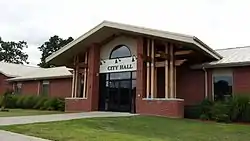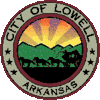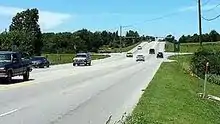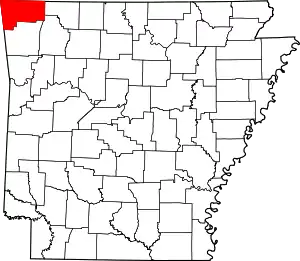Lowell, Arkansas
Lowell is a city in Benton County, Arkansas, United States. Located within the Ozarks, first settlement was along Old Wire Road in the 1840s, and although destroyed during the Civil War, the community was reestablished by J. R. McClure and thrived when the St. Louis–San Francisco Railway came through the area in the 1880s. Today, the city is a growing bedroom community within the rapidly growing Northwest Arkansas region. Lowell is also home to the headquarters of trucking company J.B. Hunt. Lowell's population was 7,327 at the 2010 census, an increase of 46% since 2000.[3]
Lowell, Arkansas | |
|---|---|
 City Hall | |
 Seal | |
 Location of Lowell in Benton County, Arkansas. | |
| Coordinates: 36°15′38″N 94°8′22″W | |
| Country | United States |
| State | Arkansas |
| County | Benton |
| Incorporated | 1881 |
| Government | |
| • Mayor | Chris Moore |
| Area | |
| • Total | 9.68 sq mi (25.06 km2) |
| • Land | 9.61 sq mi (24.90 km2) |
| • Water | 0.06 sq mi (0.16 km2) |
| Elevation | 1,342 ft (409 m) |
| Population (2010) | |
| • Total | 7,327 |
| • Estimate (2019)[2] | 9,544 |
| • Density | 992.72/sq mi (383.30/km2) |
| Time zone | UTC-6 (Central) |
| • Summer (DST) | UTC-5 (Central) |
| ZIP code | 72745 |
| Area code(s) | 479 |
| FIPS code | 05-41720 |
| GNIS feature ID | 0077562 |
| Website | www |
Geography
According to the United States Census Bureau, Lowell has a total area of 9.2 square miles (23.9 km2), of which 9.2 square miles (23.7 km2) is land and 0.077 square miles (0.2 km2), or 0.68%, is water.[3] Lowell is located in southern Benton County at 36°15′38″N 94°8′22″W (36.260429, -94.139570).[6] It is bordered by the cities of Springdale to the south, Cave Springs to the west and Rogers to the north. 4 miles (6 km) to the east is Beaver Lake, a large reservoir of the White River.
Metropolitan area
The Northwest Arkansas consists of three Arkansas counties: Benton, Madison, and Washington. The area had a population of 347,045 at the 2000 census which had increased to 463,204 by the 2010 Census (an increase of 33.47 per cent). The area does not consist of the usual principal-city-with-suburbs morphology; instead the four principal cities are all located along Interstate 49 in a linear configuration. Lowell is also located along this corridor, between Springdale and Rogers.
Demographics
| Historical population | |||
|---|---|---|---|
| Census | Pop. | %± | |
| 1910 | 193 | — | |
| 1920 | 227 | 17.6% | |
| 1930 | 262 | 15.4% | |
| 1940 | 271 | 3.4% | |
| 1950 | 341 | 25.8% | |
| 1960 | 277 | −18.8% | |
| 1970 | 653 | 135.7% | |
| 1980 | 1,078 | 65.1% | |
| 1990 | 1,224 | 13.5% | |
| 2000 | 5,013 | 309.6% | |
| 2010 | 7,327 | 46.2% | |
| 2019 (est.) | 9,544 | [2] | 30.3% |
| U.S. Decennial Census[7] | |||
As of the 2010 census Lowell had a population of 7,327. The racial and ethnic composition of the population was 68.7% non-Hispanic white, 0.9% black or African American, 1.4% Native American, 2.7% Asian, 0.4% Pacific Islander, 2.6% from two or more races and 24.7% Hispanic or Latino.[8]
As of the census[9] of 2000, there were 5,013 people, 1,914 households, and 1,381 families residing in the city. The population density was 800.7 people per square mile (309.2/km2). There were 2,044 housing units at an average density of 326.5 per square mile (126.1/km2). The racial makeup of the city was 88.67% White, 0.78% Black or African American, 0.88% Native American, 2.71% Asian, 0.98% Pacific Islander, 4.09% from other races, and 1.90% from two or more races. 8.94% of the population were Hispanic or Latino of any race.
There were 1,914 households, out of which 40.0% had children under the age of 18 living with them, 62.4% were married couples living together, 6.2% had a female householder with no husband present, and 27.8% were non-families. 22.5% of all households were made up of individuals, and 3.8% had someone living alone who was 65 years of age or older. The average household size was 2.62 and the average family size was 3.11.
In the city, the population was spread out, with 28.7% under the age of 18, 10.6% from 18 to 24, 40.5% from 25 to 44, 15.0% from 45 to 64, and 5.1% who were 65 years of age or older. The median age was 29 years. For every 100 females, there were 103.5 males. For every 100 females age 18 and over, there were 104.8 males.
The median income for a household in the city was $48,063, and the median income for a family was $55,944. Males had a median income of $31,677 versus $24,196 for females. The per capita income for the city was $20,861. About 4.4% of families and 5.9% of the population were below the poverty line, including 5.8% of those under age 18 and 19.4% of those age 65 or over.
Education
Public education for elementary and secondary students is provided by several school districts depending on resident's location:
- Rogers School District, which leads to graduation from Rogers High School or Rogers Heritage High School. Lowell is home to Lowell Elementary School and Elza R. Tucker Elementary School, which is administered by the Rogers School District.
- Bentonville School District, which leads to graduation from Bentonville High School.
- Lowell Elementary School was named as a 2015 Arkansas Reward School for Top 5% performance [10] for High Student Performance and Academic Growth.
Grace Lutheran School is a Christian pre-school and grade school of the Wisconsin Evangelical Lutheran Synod in Lowell.[11]
Infrastructure
Transportation

U.S. Route 71B passes through the center of Lowell as Bloomington Street and leads north 5 miles (8 km) to the center of Rogers and south 5 miles to the center of Springdale. Interstate 49 and U.S. Route 71 pass to the west of downtown Lowell, with access to the city at Exit 78 (Arkansas Highway 264). I-49 leads north 14 miles (23 km) to its end north of Bentonville and south 14 miles (23 km) to Fayetteville and 69 miles (111 km) to Fort Smith. Highway 264 is a main east-west road in Lowell, connecting I-49 and US 71B.
Utilities
Water and sewer service in Lowell is mostly provided by Springdale Water Utilities, with a small portion of northern Lowell receiving service from Rogers Water Utilities. Subdivisions in western Lowell operate on decentralized sewer systems due to a lack of available gravity sewer service.
Potable water for much of Northwest Arkansas is treated by Beaver Water District's water treatment plant, located in eastern Lowell near Beaver Lake. Wastewater is collected by gravity sewer and sent to a lift station near the Monroe Avenue exit on I-49. It is then pumped south, eventually being treated at the Springdale Wastewater Treatment Plant.
Notable person
- Duncan Baird, District 96 state representative; securities trader in Lowell; candidate for state treasurer in 2014[12]
References
- "2019 U.S. Gazetteer Files". United States Census Bureau. Retrieved June 30, 2020.
- "Population and Housing Unit Estimates". United States Census Bureau. May 24, 2020. Retrieved May 27, 2020.
- "Geographic Identifiers: 2010 Demographic Profile Data (G001): Lowell city, Arkansas". U.S. Census Bureau, American Factfinder. Archived from the original on February 12, 2020. Retrieved September 23, 2013.
- History of Benton, Washington, Carroll, Madison, Crawford, Franklin, and Sebastian Counties, Arkansas. Higginson Book Company. 1889. p. 110.
- "Post Offices". Jim Forte Postal History. Retrieved 5 January 2017.
- "US Gazetteer files: 2010, 2000, and 1990". United States Census Bureau. 2011-02-12. Retrieved 2011-04-23.
- "Census of Population and Housing". Census.gov. Retrieved June 4, 2015.
- 2010 general profile of population and housing characteristics of Lowell from the Us census
- "U.S. Census website". United States Census Bureau. Retrieved 2008-01-31.
- Olson, Anton. "Reward Schools 2015" (PDF). Reward Schools 2015. Kevin Ward. Retrieved 2016-10-05.
- "Grace Lutheran School and Preschool".
- "Baird Announces for State Treasurer". duncanbaird.com. Archived from the original on December 13, 2013. Retrieved December 10, 2013.

